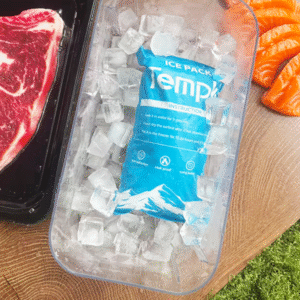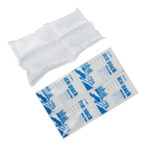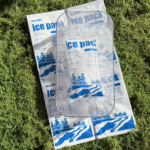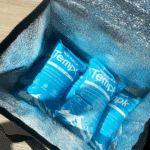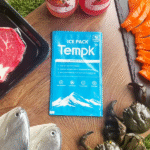حزم الجليد الهلام مقابل الجليد الجاف: ما هو أفضل حل لسلسلة التبريد في 2025?
في عالم الخدمات اللوجستية السلسلة الباردة, يؤثر اختيار حل التبريد بشكل كبير على سلامة المنتج وكفاءة الشحن. ونحن ننتقل إلى 2025, يستمر استخدام اثنين من الخيارات الأكثر شيوعًا للحفاظ على درجة الحرارة المناسبة أثناء النقل - عبوات الثلج الهلامية والثلج الجاف - على نطاق واسع. هذه المقالة سوف تقارن الايجابيات, سلبيات, وتطبيقات عبوات الثلج الهلامية مقابل الثلج الجاف, مساعدتك في اتخاذ قرار مستنير بناءً على احتياجاتك المحددة.
-
الاختلافات الرئيسية بين عبوات ثلج هلامي وثلج جاف
-
مزايا وعيوب كل حل
-
كيف تؤثر طرق التبريد هذه على لوجستيات سلسلة التبريد
-
ماذا 2025 الاتجاهات الناشئة في صناعة سلسلة التبريد
ما هي عبوات الثلج الهلامي وكيف تعمل مقارنة بالثلج الجاف?
حزم الجليد هلام هي عوامل تبريد مملوءة بمادة هلامية تتجمد عند درجات حرارة منخفضة. تعمل عن طريق امتصاص الحرارة أثناء ذوبانها, الحفاظ على درجة حرارة تبريد ثابتة لفترات أطول. تستخدم عبوات الجل بشكل شائع في شحن المواد الغذائية, نقل المنتجات الطبية, وغيرها من الشحنات الحساسة لدرجة الحرارة.
الجليد الجاف, على الجانب الآخر, هو ثاني أكسيد الكربون الصلب (co₂) يتصاعد مباشرة إلى غاز عند درجة حرارة -78.5 درجة مئوية. فهو يوفر درجات حرارة منخفضة للغاية مثالية للمنتجات التي يجب أن تظل مجمدة. لكن, يحمل الثلج الجاف مخاطر التعامل مثل الحروق المحتملة أو قضمة الصقيع ويتطلب تخزينًا وتهوية متخصصة بسبب إطلاق غاز ثاني أكسيد الكربون..
الفرق الرئيسي يكمن في نطاق درجة الحرارة و سلامة التعامل— تحافظ عبوات الثلج الهلامية على تبريد أكثر اعتدالًا, في حين أن الثلج الجاف يوفر برودة شديدة ولكنه يأتي مع مخاطر إضافية.
الفوائد الرئيسية لأكياس الثلج الهلامية مقابل الثلج الجاف
| ميزة | حزم الجليد هلام | الجليد الجاف |
|---|---|---|
| نطاق درجة الحرارة | -20درجة مئوية إلى -30 درجة مئوية | -78.5درجة مئوية |
| التعامل مع السلامة | من السهل التعامل معها, لا توجد احتياطات خاصة مطلوبة | يتطلب القفازات, تهوية, والحرص على تجنب قضمة الصقيع |
| التأثير البيئي | قابلة للتحلل البيولوجي وقابلة لإعادة التدوير | انبعاثات CO₂ |
| يكلف | قابلة لإعادة الاستخدام, فعالة من حيث التكلفة على المدى الطويل | تكلفة عالية, استخدام واحد |
عبوات الثلج الهلامية آمنة وسهلة الاستخدام, صديقة للبيئة, وفعالة من حيث التكلفة على المدى الطويل. في المقابل, يعتبر الثلج الجاف مثاليًا لاحتياجات البرد الشديد ولكنه يتطلب معالجة دقيقة وله تأثير بيئي أكبر.
كيف يمكن مقارنة أداء عبوات الثلج الهلامية بالثلج الجاف?
تعتبر عبوات الثلج الهلامية مثالية للمنتجات التي تتطلب درجات حرارة تتراوح من 2 درجة مئوية إلى 8 درجات مئوية, مثل المواد الغذائية الطازجة, المشروبات, والمستحضرات الصيدلانية. أنها توفر تأثير تبريد ثابت على مدى فترات طويلة (حتى 48 ساعات), مما يجعلها مثالية للشحنات القصيرة إلى المتوسطة المدة.
الجليد الجاف, لكن, مناسب بشكل أفضل للمنتجات التي تتطلب درجات حرارة منخفضة للغاية, مثل المواد البيولوجية, اللقاحات, أو بعض المنتجات الصيدلانية التي يجب أن تظل مجمدة. بينما يستمر الثلج الجاف لفترة أطول (حتى 72 ساعات), يتطلب استخدامه تهوية مناسبة وبروتوكولات أمان صارمة لتجنب تراكم ثاني أكسيد الكربون.
مزايا وعيوب عبوات الثلج الهلامية مقابل الثلج الجاف
مزايا عبوات الثلج الهلامية:
-
معالجة أكثر أمانًا: على عكس الجليد الجاف, عبوات الثلج الهلامية غير سامة, لا تشكل مخاطر قضمة الصقيع, ويمكن التعامل معها دون معدات خاصة.
-
صديقة للبيئة: عادةً ما تكون عبوات الثلج الهلامية قابلة لإعادة الاستخدام ومصنوعة من مواد قابلة للتحلل, الحد من التأثير البيئي على المدى الطويل.
-
فعالة من حيث التكلفة: حيث يمكن إعادة استخدام عبوات الثلج الهلامية, أنها توفر حلاً أكثر اقتصادا مع مرور الوقت, وخاصة بالنسبة للشحنات المتكررة.
-
التنوع: إنها مناسبة لمجموعة واسعة من الصناعات, بما في ذلك الطعام, الأدوية, والتجارة الإلكترونية, توفير تبريد موثوق به في العديد من التطبيقات.
مساوئ عبوات الثلج الهلامية:
-
نطاق درجة حرارة محدود: لا تستطيع عبوات الثلج الهلامية تحقيق درجات الحرارة القصوى المطلوبة لبعض المنتجات, مما يجعلها غير مناسبة للبضائع المجمدة.
-
وقت الذوبان: في المناخات الأكثر حرارة أو العبور الممتد, قد تتطلب عبوات الجل استبدالًا متكررًا لأنها تذوب بشكل أسرع من الثلج الجاف.
مزايا الجليد الجاف:
-
درجات حرارة منخفضة للغاية: يوفر الثلج الجاف درجات حرارة تبريد أقل بكثير من درجة التجمد, مثالية للمواد التي تتطلب التجميد العميق.
-
يدوم طويلاً: يمكن للثلج الجاف أن يحافظ على درجة حرارة منخفضة لفترات طويلة, مما يجعلها مثالية للشحنات لمسافات طويلة أو عندما يكون التجميد ضروريًا.
عيوب الثلج الجاف:
-
التعامل مع المخاطر: يمكن أن يسبب الثلج الجاف قضمة الصقيع ويتطلب التهوية بسبب تسامي غاز ثاني أكسيد الكربون.
-
تكلفة عالية: غالبًا ما يكون الثلج الجاف حلاً للاستخدام مرة واحدة, والتي يمكن أن تكون مكلفة للشحنات المتكررة.
-
المخاوف البيئية: يؤدي تسامي الثلج الجاف إلى إطلاق ثاني أكسيد الكربون, المساهمة في انبعاثات الغازات الدفيئة عندما لا يتم التعامل معها بشكل صحيح.
اختيار حل سلسلة التبريد المناسب لمنتجاتك
يعتمد الاختيار بين عبوات الثلج الهلامية والثلج الجاف إلى حد كبير على متطلبات درجة الحرارة, مدة الشحن, و سلامة التعامل اللازمة لشحنتك.
لحزم جل الثلج:
تعتبر عبوات الثلج الهلامية مثالية للسلع التي تحتاج إلى البقاء ضمن نطاق درجة حرارة معتدلة (2-8 درجة مئوية), مثل:
-
طعام طازج (على سبيل المثال, ثمار, خضروات, ومنتجات الألبان)
-
الأدوية واللقاحات
-
شحنات التجارة الإلكترونية للبقالة ومجموعات الوجبات
حالات الاستخدام: تعتبر عبوات الثلج الهلامية مناسبة أيضًا للصناعات التي تبحث عن الاستدامة, منخفضة التكلفة, وخيارات الشحن الآمنة. على سبيل المثال, يمكن لخدمة توصيل البقالة الاستفادة من عبوات الجل للحفاظ على الطعام طازجًا دون المخاطرة بتجميد المنتجات.
للثلج الجاف:
يعد الثلج الجاف ضروريًا عند التعامل مع المنتجات التي تحتاجها درجات الحرارة المتجمدة, مثل:
-
الأطعمة المجمدة واللحوم (على سبيل المثال, بوظة, المأكولات البحرية, والوجبات المجمدة)
-
العينات البيولوجية والمواد البحثية المخبرية
-
الإمدادات الطبية التي يجب أن تظل مجمدة بشدة
حالات الاستخدام: يُستخدم الثلج الجاف بشكل شائع في شحن المواد البيولوجية, معدات المختبرات, والمنتجات المتخصصة التي لا تستطيع تحمل التغيرات في درجات الحرارة أو التلف.
الاتجاهات والابتكارات للوجستيات سلسلة التبريد في 2025
ونحن نقترب 2025, يتم تشكيل الخدمات اللوجستية لسلسلة التبريد من خلال التقدم التكنولوجي, الاستدامة, ومواد التعبئة والتغليف. حزم الجليد هلام يتم تطويرها بشكل متزايد مع مواد تغيير المرحلة (PCMS) لتمديد فترات التبريد, بينما الثلج الجاف وتركز البدائل على الحد من آثار الكربون. بالإضافة إلى ذلك, أكثر صديقة للبيئة عبوات جل الثلج و أجهزة الاستشعار الذكية يتم دمجها في حلول سلسلة التبريد لمراقبة درجات الحرارة في الوقت الفعلي وتقليل أوجه القصور.
وتشير توقعات السوق إلى أن سوق الخدمات اللوجستية لسلسلة التبريد تم تعيينه للنمو بواسطة 10% سنويًا حيث أصبحت الاستدامة موضع تركيز أكبر لكل من الشركات والمستهلكين. التعبئة والتغليف القابلة لإعادة التدوير للثلج الجاف وطرق التبريد الهجينة التي تجمع بين عبوات الثلج الهلامية والثلج الجاف تكتسب قوة جذب.
الأسئلة الشائعة حول عبوات الثلج الهلامية مقابل الثلج الجاف
س 1: هل أكياس الثلج الهلامية أكثر أمانًا في التعامل معها من الثلج الجاف؟?
نعم, عبوات الثلج الهلامية غير سامة ولا تشكل مخاطر مثل قضمة الصقيع أو الاختناق. فهي آمنة لعمليات التسليم التي يواجهها المستهلك ولا تتطلب معدات متخصصة.
Q2: كم من الوقت تبقى عبوات الثلج الهلامية باردة؟?
تحافظ عبوات الثلج الهلامي عادةً على درجة حرارة تتراوح بين 2-8 درجات مئوية لمدة تصل إلى 20 درجة مئوية 48 ساعات, اعتمادا على العزل وحجم العبوة.
س 3: هل يمكن أن تحافظ عبوات الثلج على اللحوم مجمدة؟?
لا, عبوات الثلج الهلامية ليست مناسبة للأشياء المجمدة. للحوم المجمدة أو الآيس كريم, الثلج الجاف ضروري للحفاظ على درجات حرارة تحت الصفر.
س 4: هل هناك لوائح للشحن مع الثلج الجاف?
نعم, يتم تصنيف الثلج الجاف على أنه مادة خطرة ويجب شحنه وفقًا للوائح محددة. حزم الجليد هلام, على الجانب الآخر, ليس لديهم متطلبات تنظيمية خاصة.
خاتمة
الاختيار بين عبوات جل الثلج و الثلج الجاف يتلخص ذلك في طبيعة المنتج الذي يتم شحنه ودرجة الحرارة المطلوبة. لاحتياجات التبريد, عبوات جل الثلج هي أكثر أمانا, أكثر استدامة, وخيار فعال من حيث التكلفة, بينما الثلج الجاف لا غنى عنه لمتطلبات درجات الحرارة المنخفضة للغاية. من خلال تقييم عوامل مثل نطاق درجة الحرارة, مدة الشحن, أمان, و التأثير البيئي, يمكنك اختيار الحل الأفضل لضمان النقل الآمن والفعال لبضائعك.
رؤى قابلة للتنفيذ:
-
قم بتقييم احتياجات درجة حرارة منتجك: يتطلب التبريد عبوات ثلج هلامية, بينما التجميد يتطلب الثلج الجاف.
-
الجمع بين الحلول للشحن الهجين: استخدم عبوات الثلج الهلامي والثلج الجاف للشحنات التي تتطلب درجات حرارة مختلفة.
-
ابق على اطلاع مع 2025 الاتجاهات: استثمر في المواد الصديقة للبيئة وأدوات المراقبة الذكية لتعزيز إستراتيجيتك اللوجستية لسلسلة التبريد.
حول Tempk
Tempk هي شركة رائدة في مجال تعبئة سلسلة التبريد, تقدم مبتكرة عبوات جل الثلج و حلول الثلج الجاف لتلبية الاحتياجات اللوجستية المتنوعة. تم تصميم منتجاتنا لضمان الشحن الآمن والفعال للسلع الحساسة لدرجة الحرارة, مع التركيز على الاستدامة والامتثال. اتصل بنا اليوم لتعرف كيف يمكن لحلولنا تحسين عمليات سلسلة التبريد الخاصة بك.






